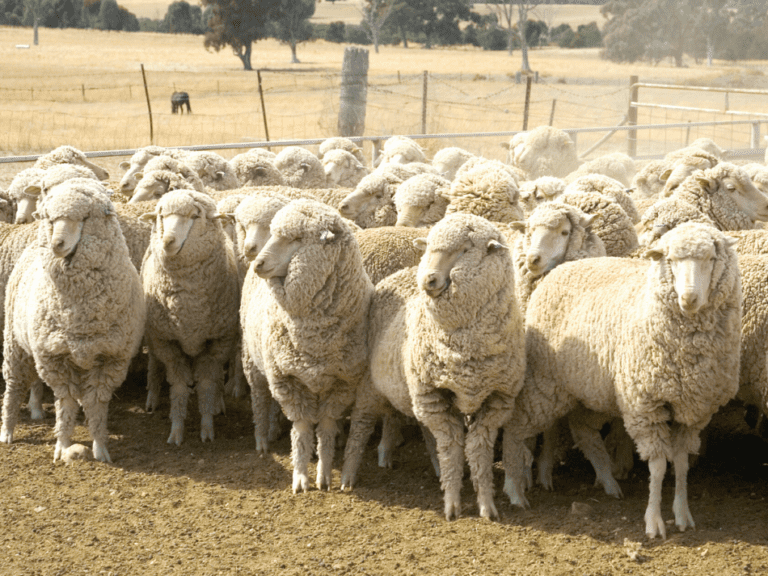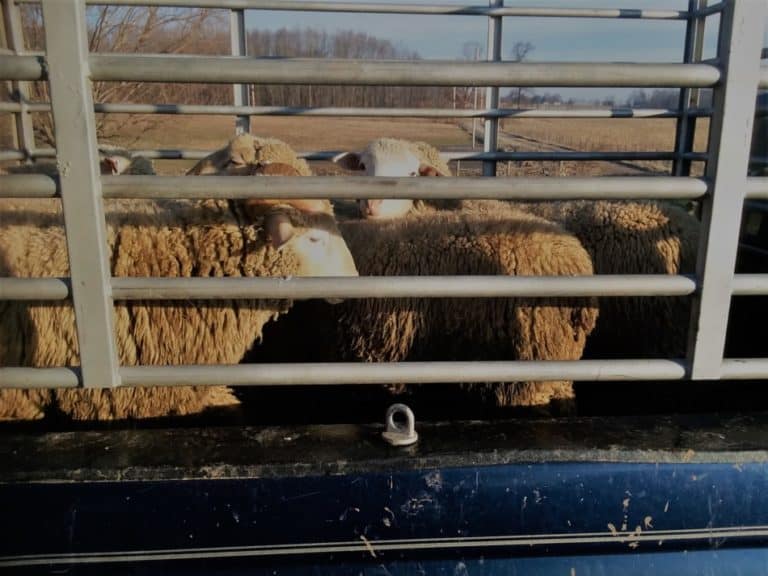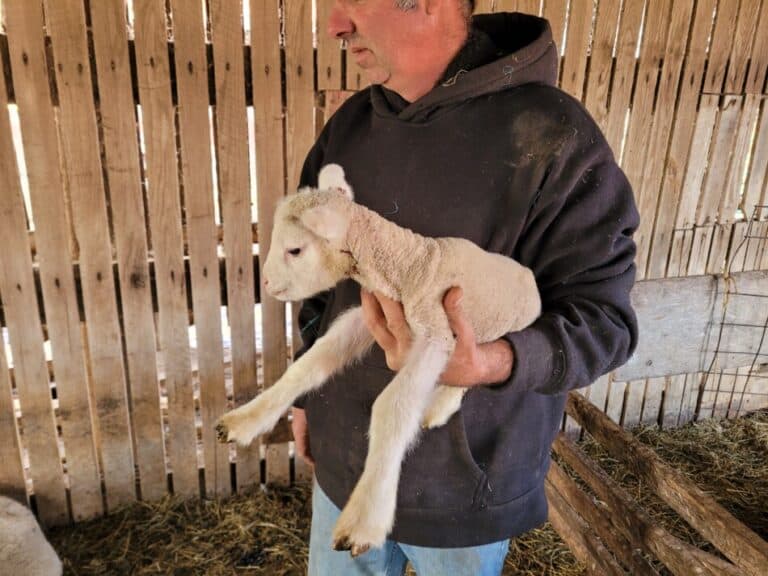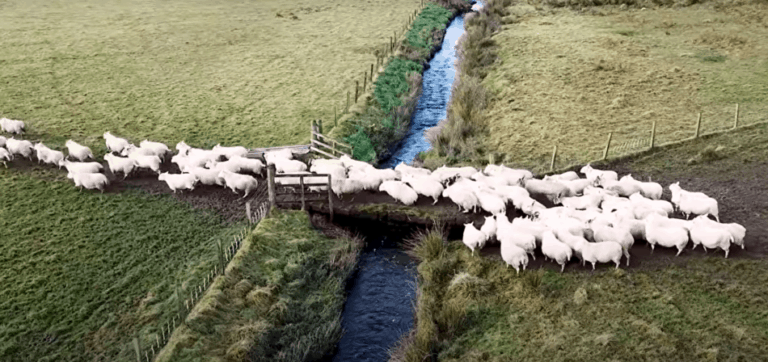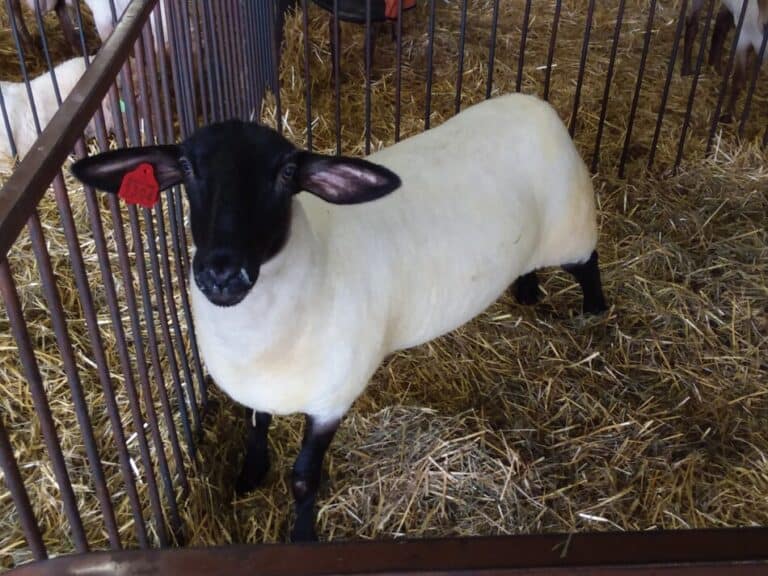8 Signs That Your Sheep Is About To Give Birth

You’re expecting lambs! According to the calendar, your flock’s lambing start date is anytime. Wow, a very exciting moment that’s taken some work and planning to get to!
The time you’ve been looking forward to is actually here, now what? How do you know when your ewes are about to start lambing?
Sheep that are about to give birth will have developed an udder, be restless (frequently adjusting positions) and, right before the lambs are born, she will separate herself from the flock to give birth.
First off, have your sheep in place a few weeks before lambing is to start. Once you see the more imminent signs of lambing, it’s disruptive to move the ewe. Have you flock in the lambing area, pre lambing.
The signs of lambing are listed in order of imminence.
The first few signs you’ll notice about ewes that will lamb in a few weeks, the last few are ewes that will lamb in the next few days, with the final sign being a ewe that is currently lambing.
Which Hay Is The Best For Sheep? will help you figure out the differences in your hay options and which ones will work best for you and your flock.
Ewe will have udder development
Your ewes, both mature ewes and ewe lambs, will start to develop an udder a few weeks before the lambs are due. This udder development will be more pronounced the closer she gets to lambing.
If you can see a bit of an udder, all you know is that she is getting her body ready for lambs, but you really don’t have a timeline, other than soon, as in the next few weeks.
Ewe will have relaxed vulva
Along with the developing udder, a ewe or ewe lamb soon to give birth will have a relaxed vulva. Depending upon how much wool your sheep have and if they have longer tails or not, the relaxed vulva may be hard to see.
This is another one of those signs that really does not tell you much today. Her body is getting ready to have lambs, which is wonderful, but the specifics of the timeline are still a mystery to all, but her.
From the front or back, ewe looks less wide than a few days ago
When you look at your ewe from one end or another, you’ll see that her tum doesn’t stick out as wide as it did before. She looks to be slimming down. But she isn’t, all that is happening is that the lambs are lining up to be born.
In late gestation, the lambs can stick out pretty wide, it always looks to me like she swallowed a watermelon, whole! This is the waddling, super wide stage, which means the lambs are growing well.
Right before the lambs are born they will turn to line up to leave during birth. In case you didn’t know, lambs “dive” out of the birth canal, a position which has them lined up spine to spine with their mom.
This makes her look like she is less of a walking watermelon, that’s really just a change in the position of the lambs.
Ewe is laying down but not chewing cud
Now we move to sings of lambing that are closer to the actual lambing. First up is the ewe not chewing her cud.
This would look like her laying down, just like everybody else out there, but when you look closely you can see she is just sitting, not chewing her cud.
This is odd, since all the other ewes are happily chewing away and she is sitting there looking bored or uncomfortable. So, what should you do about it? Nothing, just make note of who she is and check back in a few hours.
Ewe is not doing what others are doing
Once you see a ewe doing things the other ewes are not doing, something is up. Happy and contented sheep function as a group.
If it’s time to lay down, to chew their cud or to sleep for the night, they all lay down. If it’s time to go out and see what else is growing in the pasture, they’ll all go out.
What you’ll see is the whole flock laying down and one, in the middle of the group, is up but not really going anywhere or doing anything, she’s just standing.
Or you may see the opposite, all the rest of the flock is grazing, except one in the group is laying down. She’s still out with the group, just doing something different.
To be fair, she could be sitting because she has bad feet or maybe she’s just the first to sit and they’ll all be sitting there in a few minutes. Or she’s uncomfortable and soon to lamb, so she’s changing position to see if that helps.
You’ll know more when you check back and see. All you need to do is note who she is and check back in a few hours to see how she is doing.
Ewe is restless, changing positions frequently
Now, your ewe is a bit closer than she was in the few signs listed above. If she is constantly changing positions and everybody else in the group is comfortable, something is up.
Just keep an eye on her. Unless there is a good reason for it, like out of no where terrible weather coming tonight, she will be better off with her flock.
You may be tempted to “go check on her”. That is more likely going to stress her and interrupt the process. Note the time and give her space.
Right before birth, ewe will go off to be by herself
Right before the lambs are born, the ewe will separate herself from the rest of the flock, if she can, to have her lambs and get them started for the first few hours without the interference of other ewes or curious lambs.
The ewe wants to be by herself and will pick a spot that is isolated.
The catch here is that if you have options where the sheep can go, chances are the main flock will “hog” the nice areas, like a well bedded shelter, and the soon to be mom will go somewhere else, not as well suited to her needs.
So, what do you do here? Prevent this from happening, if you have parts of the pasture that you do not want the soon to be moms to go for birth.
Lock all the sheep in a good spot overnight, then let them out in the morning or just fence them out of the questionable areas of the pasture and make sure there are plenty of sheltered areas and windbreaks for her to find.
When you can see part of placenta, birth of lambs will be soon
Now we are right in the thick of it! If you can see part of the placenta, usually the “water bag” that breaks, the ewe is actually in labor.
What should you do now? Nothing, keep your distance and let her do her work, especially if she is a first time mom, since they are much more easily confused and “spooked” off of their lambs.
Keep your distance unless you are positive that she needs assistance with a hard birth. You should see front feet then have the first lamb born within 30-45 minutes.
Don’t interfere until you give her time, when you mess, you run the risk of her not accepting the lambs.
Note the time and come back in 15 minutes or so, to see if she is progressing, then reevaluate.
Also, consider that sheep know the difference between people. If at all possible, have the person the sheep are most comfortable with be the one checking in at lambing.
Here’s an informative article from Virginia Cooperative Extension on Lambing Time Management, for more details.

